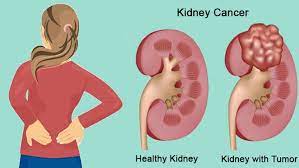The kidneys are two bean-shaped organs, each about the size of a fist. They’re located in your abdomen on either side of your spine. The kidneys filter out waste from your blood and make urine. There are different types of cancer that can affect your kidneys.
The National Cancer Institute estimates that there were more than 63,000 new cases of kidney cancer in the United States in 2017.
The incidence of kidney cancer appears to be increasing, according to the Mayo Clinic. One possible reason may be increased screening by CT scans.
Symptoms of kidney cancer
Kidney cancer doesn’t usually cause any symptoms in its early stages. As the cancer progresses, the symptoms may include:
- persistent back pain, especially just below your ribs
- blood in your urine
- abdominal pain
- abdominal swelling
- a lump in the abdomen
- fatigue
- flank pain
- recurring fevers
- unexplained weight loss
- anemia
What are the types of kidney cancer?
Several types of cancer can affect the kidneys. Adenocarcinoma of the kidney is also known as renal cell carcinoma. It’s the most common type of kidney cancer in adults and starts in the part of the kidney that filters blood. Renal pelvis carcinoma starts in the part of the kidney where urine is collected.
Wilms’ tumor is the most common type of kidney cancer in children under the age of 5.
There are other types of kidney cancer, but they’re rare.
Causes and risk factors of this cancer
The cause of kidney cancer is unknown. The risk factors for kidney cancer include:
- smoking
- obesity
- hypertension
- family history
- older age
- being male
- kidney disease
- being exposed to toxins in the workplace
There are also several inherited conditions that can increase your risk of kidney cancer. These include von Hippel-Lindau disease and hereditary papillary renal cell carcinoma.
How kidney cancer is diagnosed
A diagnosis of kidney cancer requires a complete history and physical exam. Your doctor will look for an abdominal swelling or a lump in your abdomen. In men, the doctor may also look for an enlarged, twisted vein, or varicocele, in the scrotum.
Some tests that can be used to detect kidney cancer include:
Complete blood count
The kidneys produce a hormone called erythropoietin that stimulates the production of red blood cells. A complete blood count can reveal if the red blood cell count is high, which would indicate polycythemia, or low, which would indicate anemia.
Blood chemistry tests
Blood chemistry tests can help show how well your kidneys are functioning. Kidney cancer can also influence the levels of some types of chemicals in your blood, such as liver enzymes and calcium.
Urinalysis
A urinalysis can allow your doctor to determine if there’s blood present in your urine. It may also reveal other signs of an infection.
Ultrasound of the abdomen and kidneys
An abdominal ultrasound can measure the size and shape of your kidneys. If a tumor is present, it may reveal its size and consistency.
Renal angiography
In this test, your doctor threads a catheter up a large artery in your leg or groin, to the renal artery. They’ll inject a special dye into the artery. After the dye is injected, they’ll take a series of X-rays. This helps your doctor see the blood supply to your kidneys in detail. If a tumor is present, the blood supply to the tumor can be seen.
Intravenous pyelogram
In this test, a healthcare provider will inject a special dye into one of your veins. The dye allows your kidneys to be seen more clearly with X-rays. This test can help your doctor find a tumor or obstruction.
CT scan of the abdomen
A CT scan is a noninvasive test that uses X-rays to create cross-sectional images of your body. It allows the following to be viewed:
- bones
- muscles
- fat
- organs
- blood vessels
It can be used to find out if cancer has spread beyond the kidney.
The following tests can also be used to find out if kidney cancer has spread:
- an MRI scan of the abdomen
- a bone scan
- a chest X-ray
- a PET scan
- a chest or abdominal CT scan
Treatment options for kidney cancer
The treatment for kidney cancer focuses on removing the tumor from your body. This is usually done through surgery. Surgery can be radical or conservative.
Radical nephrectomy
A radical nephrectomy is a surgical procedure that removes your kidney. The entire organ is removed, along with some surrounding tissue and lymph nodes. The adrenal gland may be removed as well. The surgery can be done through a large incision or with a laparoscope, which consists of a thin tube with a tiny camera at one end.
Conservative nephrectomy
Conservative nephrectomy removes only the tumor, lymph nodes, and some surrounding tissue. Part of the kidney is left behind. This is also known as a nephron-sparing nephrectomy. Tumor cells can also be killed by freezing, which is called cryosurgery, or radiofrequency ablation, which involves applying heat.
Metastatic kidney cancer
Metastatic kidney cancer can’t be treated with surgery alone. After as much tumor is removed as possible with surgery, other treatments may be necessary. These may include immunotherapy, targeted therapy, and radiation. The treatments can have side effects.
Immunotherapy
Immunotherapy uses synthetic versions of immunoactive chemicals found in the body. Interferon and aldesleukin (Proleukin) are examples of drugs used in immunotherapy.
Targeted drugs
Targeted drugs are designed to block certain abnormal signals present in kidney cancer cells. Examples of targeted drugs include:
- axitinib (Inlyta)
- bevacizumab (Avastin)
- pazopanib (Votrient)
- sorafenib (Nexavar)
- sunitinib (Sutent)
They help stop the formation of new blood vessels to supply nutrients to the cancer cells.
Long-term outlook for people with kidney cancer
The outlook for people with kidney cancer varies. It depends on how quickly the cancer is caught and how it responds to treatment.
Approximately 65 percent Trusted Source of kidney and renal pelvis cancers are diagnosed before they have spread. The cancer can or spread, or metastasize, to the other kidney, but it’s most likely to spread to the lungs. Metastatic cancer is harder to treat.
Kidney cancer can also be complicated by:
- high blood pressure
- high levels of calcium in the blood
- overproduction of red blood cells
- liver problems
Survival rates for kidney cancer are higher when the condition is treated in its earlier stages. For example, the American Cancer Society reports that the observed five-year survival rate for stage 1 kidney cancer is 81 percent Trusted Source. Keep in mind that observed survival rates are estimates.
Prevention of kidney cancer
Living a healthy lifestyle is the best way to reduce your risk of kidney cancer. Specific steps you can take to reduce your risk include:
- not smoking
- eating a balanced diet
- maintaining a healthy weight
- protecting yourself from chemical toxins at work
- controlling your blood pressure






















